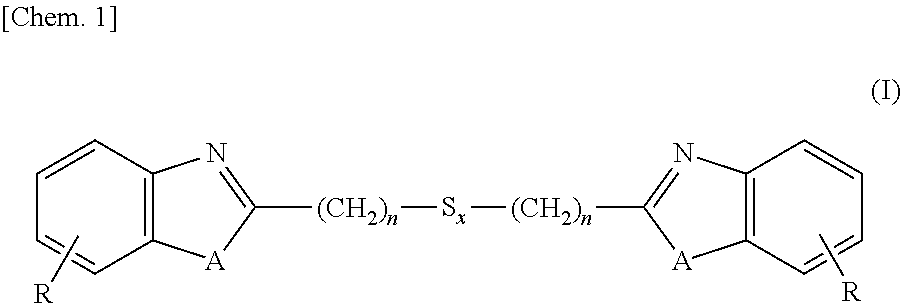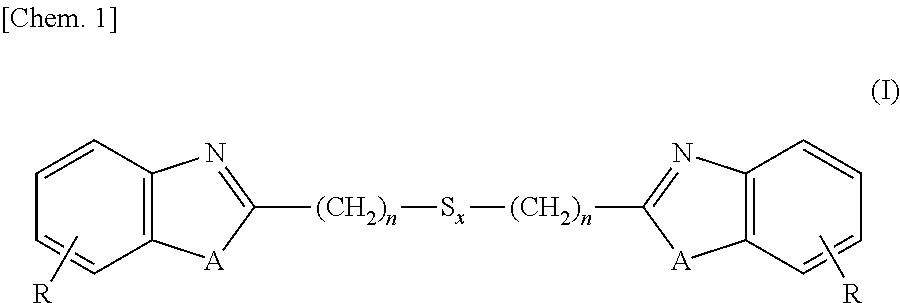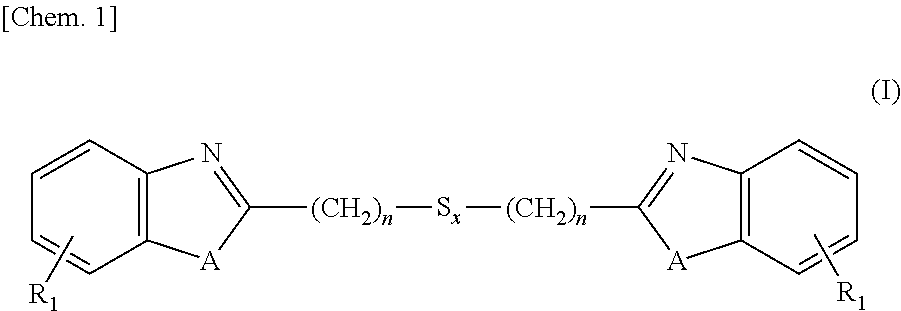Coupling agent for rubber/carbon black, and rubber composition containing same for use in tires
- Summary
- Abstract
- Description
- Claims
- Application Information
AI Technical Summary
Benefits of technology
Problems solved by technology
Method used
Image
Examples
reference example 1
Synthesis of 2EBZ
[0129]Into a 3L-flask were charged 1,250 ml (5 moles) of 4N hydrochloric acid, 260 g (2.4 moles) of 1,2-diaminobenzene and 252 g (1.2 moles) of 3,3-dithiodipropionic acid, and these ingredients were subjected to reaction under stirring for 12 hours at an internal temperature of 95° C. After the reaction solution was cooled to room temperature, thereto was added 700 ml of 25% ammonia water and stirring was continued for additional 2 hours under cooling with water. Precipitates formed in the reaction system were isolated, washed with water and dried, thereby obtaining 380 g (1.1 moles, a 89% yield) of the intended 2,2′-bis(benzimidazolyl-2)ethyl disulfide.
reference example 2
Synthesis of 4EBZ
[0130]Into a 3L-flask were charged 1,250 ml (5 moles) of 4N hydrochloric acid, 260 g (2.4 moles) of 1,2-diaminobenzene and 329 g (1.2 moles) of 3,3-tetrathiodipropionic acid, and these ingredients were subjected to reaction under stirring for 18 hours at an internal temperature of 95° C. After the reaction solution was cooled to room temperature, thereto was added 700 ml of 25% ammonia water and stirring was continued for additional 2 hours under cooling with water. Precipitates formed in the reaction system were isolated, washed with water and dried, thereby obtaining 426 g (1.0 mole, a 85% yield) of the intended 2,2′-bis(benzimidazolyl-2)ethyl tetrasulfide.
reference example 3
Synthesis of 2EBO
[0131]Into a 3L-flask were charged 1,250 ml (5 moles) of 4N hydrochloric acid, 262 g (2.4 moles) of 2-aminophenol and 329 g (1.2 moles) of 3,3-dithiodipropionic acid, and these ingredients were subjected to reaction under stirring for 24 hours at an internal temperature of 95° C. After the reaction solution was cooled to room temperature, thereto was added 700 ml of 25% ammonia water and stirring was continued for additional 2 hours under cooling with water. Precipitates formed in the reaction system were isolated, washed with water and dried, thereby obtaining 392 g (1.1 moles, a 92% yield) of the intended 2,2′-bis(benzoxazolyl-2)ethyl disulfide.
PUM
| Property | Measurement | Unit |
|---|---|---|
| Percent by mass | aaaaa | aaaaa |
| Percent by mass | aaaaa | aaaaa |
| Percent by mass | aaaaa | aaaaa |
Abstract
Description
Claims
Application Information
 Login to View More
Login to View More - R&D
- Intellectual Property
- Life Sciences
- Materials
- Tech Scout
- Unparalleled Data Quality
- Higher Quality Content
- 60% Fewer Hallucinations
Browse by: Latest US Patents, China's latest patents, Technical Efficacy Thesaurus, Application Domain, Technology Topic, Popular Technical Reports.
© 2025 PatSnap. All rights reserved.Legal|Privacy policy|Modern Slavery Act Transparency Statement|Sitemap|About US| Contact US: help@patsnap.com



